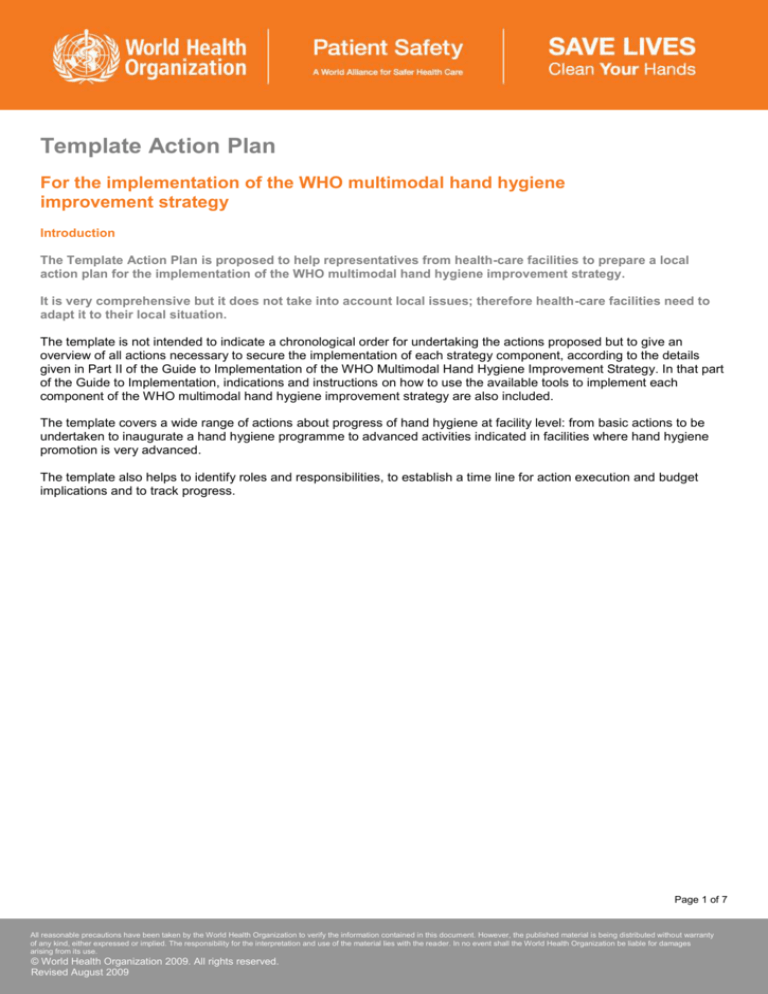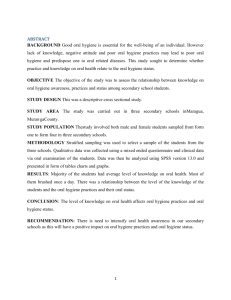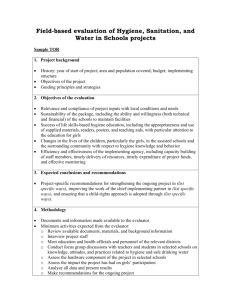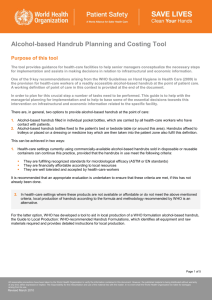
Template Action Plan
For the implementation of the WHO multimodal hand hygiene
improvement strategy
Introduction
The Template Action Plan is proposed to help representatives from health-care facilities to prepare a local
action plan for the implementation of the WHO multimodal hand hygiene improvement strategy.
It is very comprehensive but it does not take into account local issues; therefore health-care facilities need to
adapt it to their local situation.
The template is not intended to indicate a chronological order for undertaking the actions proposed but to give an
overview of all actions necessary to secure the implementation of each strategy component, according to the details
given in Part II of the Guide to Implementation of the WHO Multimodal Hand Hygiene Improvement Strategy. In that part
of the Guide to Implementation, indications and instructions on how to use the available tools to implement each
component of the WHO multimodal hand hygiene improvement strategy are also included.
The template covers a wide range of actions about progress of hand hygiene at facility level: from basic actions to be
undertaken to inaugurate a hand hygiene programme to advanced activities indicated in facilities where hand hygiene
promotion is very advanced.
The template also helps to identify roles and responsibilities, to establish a time line for action execution and budget
implications and to track progress.
Page 1 of 7
All reasonable precautions have been taken by the World Health Organization to verify the information contained in this document. However, the published material is being distributed without warranty
of any kind, either expressed or implied. The responsibility for the interpretation and use of the material lies with the reader. In no event shall the World Health Organization be liable for damages
arising from its use.
© World Health Organization 2009. All rights reserved.
Revised August 2009
Overall Template Action Plan
Action
Lead
Time frame
Budget
Progress
person
(start and end
dates)
(if
applicable)
(include review and
completion dates)
General
Access the WHO Guidelines on Hand Hygiene in Health Care (2009) on the WHO Patient Safety website
Adapt WHO Guidelines for local applicability while ensuring consistency with recommendations
Access the implementation toolkit of the WHO multimodal hand hygiene improvement strategy on the WHO
Patient Safety website
Identify a co-ordinator for the hand hygiene improvement programme and a deputy co-ordinator
Identify and establish a team/committee to support the hand hygiene co-ordinator
Identify any prior initiatives or plans on hand hygiene improvement/infection control within the facility
Contact the CEO/Director and senior managers of the hospital to discuss actions and activities to be
implemented in line with the current progress of hand hygiene/infection control promotion at facility level and
with the WHO Guidelines
Agree on the scope and extent of the activities to be acted on
Match required activity to available human resources
If policies, standards, protocols, standard operating procedures, care bundles, etc are currently used in the
facility, ensure one is focused on hand hygiene and plan for dissemination to all clinical settings/health-care
workers
Page 2 of 7
All reasonable precautions have been taken by the World Health Organization to verify the information contained in this document. However, the published material is being distributed without warranty of any kind, either expressed or implied. The responsibility for the interpretation and use of
the material lies with the reader. In no event shall the World Health Organization be liable for damages arising from its use.
Action
Lead
person
Time frame
Budget
Progress
(start and end
dates)
(if
applicable)
(include review and
completion dates)
System change
Review existing hand hygiene compliance and/or health care-associated infection (HCAI) information
available to direct the hand hygiene improvement programme
Analyse the current structures and resources:
Ward Infrastructure Survey
Soap/ Handrub Consumption Survey
Discuss with CEO/Director/senior managers how to improve infrastructures, with a long-term aim to provide
a sink in each room, complete with safe, running water, soap and hand towels (this will most likely link with
wider/national plans)
Discuss with CEO/Director/senior managers how to address availability of, and improving access to,
resources (to provide alcohol-based handrub at each point of care)
Decide whether to produce or procure alcohol-based handrub:
Arrange purchase from the (local) market, taking into account availability, efficacy, tolerability and cost
Review the Guide to Local Production: WHO-recommended Handrub Formulations
Discuss with relevant persons/experts the feasibility and actions required to produce WHO alcoholbased handrubs within the facility, particularly affordability and safety issues
Use the Alcohol-based Handrub Planning and Costing Tool to develop a budget spreadsheet for
production of WHO-recommended alcohol-based handrub
Explore with CEO/Director/senior managers the national or regional plans to provide alcohol-based
handrubs
Undertake tolerability and acceptability exercises using protocols for evaluation
Make a financial plan of costs necessary to address water, sinks, soap, towels and handrub deficits and
attempt to secure an adequate annual budget for this
If required, explore with CEO/Director/senior managers the possibility of further funding assistance to
support short, medium and long term plans (e.g. via national ministry of health funding/donor
funds/donations from industry/other donations)
Page 3 of 7
All reasonable precautions have been taken by the World Health Organization to verify the information contained in this document. However, the published material is being distributed without warranty of any kind, either expressed or implied. The responsibility for the interpretation and use of
the material lies with the reader. In no event shall the World Health Organization be liable for damages arising from its use.
Action
Lead
person
Time frame
Budget
Progress
(start and end
dates)
(if
applicable)
(include review and
completion dates)
Training / Education
Establish requirements for health-care worker training based on local numbers, needs and any other issues
Review/design a training/education programme based on WHO training tools
Identify the trainers (at least one per facility)
Identify the observers (at least one per facility)
Secure time, with support from senior managers, for trainers and observers to be trained and to perform in
their allocated roles (e.g. written agreement)
Carry out training of trainers
Carry out training of observers (trainers and observers can receive the same basic training in the same
sessions before observers receive additional specific training)
Set the plan, including timeframe, for initiating, conducting and evaluating training for health-care workers
Communicate the time commitment required for training of health-care workers to all mangers and staff
Establish a system for reporting on training sessions to senior managers including an action plan for
addressing poor or non-attendance
Incorporate the training programme into the overall facility financial plan
Establish a system for updating training and competency checks of trainers (e.g. annually)
Establish a system for updating training and competency checks of all health-care workers (e.g. annually)
Plan to produce supplementary training materials or organize additional activities to maintain momentum
and motivation (e.g. organise lunchtime debates on hand hygiene issues for health-care workers; produce elearning materials; establish a buddy system to educate new starters on hand hygiene) in the longer term
Establish a system for updating training materials
Page 4 of 7
All reasonable precautions have been taken by the World Health Organization to verify the information contained in this document. However, the published material is being distributed without warranty of any kind, either expressed or implied. The responsibility for the interpretation and use of
the material lies with the reader. In no event shall the World Health Organization be liable for damages arising from its use.
Action
Lead
person
Time frame
Budget
Progress
(start and end
dates)
(if
applicable)
(include review and
completion dates)
Evaluation and feedback
Design or review evaluation and feedback activities including:
Hand hygiene observations
Ward infrastructure surveys
Soap/handrub consumption surveys
Perception surveys for health-care workers
Perception surveys for senior managers
Health-care workers knowledge surveys
Tolerability and acceptability of alcohol-based handrub surveys
Set the plan, including timeframe, for initiation of evaluation and feedback activities
Include identification of all expert support that might be required (e.g. epidemiologist, data manager)
Incorporate the evaluation and feedback activities into the overall facility financial plan
Establish an overall system for reporting on evaluation results to senior managers including an action plan
for addressing poor compliance, knowledge and infrastructures
Utilise the Hand Hygiene Technical Reference Manual to produce plans for observations
Identify candidates to be observers (if not already done so)
Establish a system for on-going training and competency checks of observers (e.g. annually)
Conduct baseline evaluations and feed back to key health-care staff, consider using:
Data Entry and Analysis Tool and Instructions for Data Entry and Analysis
Data Summary Report Framework
Prepare and disseminate a plan for ongoing observations according to an agreed schedule (e.g. annually
but ideally bi-monthly)
Present results of observations each quarter or to an agreed schedule to hand hygiene implementation team
and senior management
Set annual targets for improvement in hand hygiene compliance based on agreement from all key staff and
taking into account current evidence on hand hygiene compliance rates
Page 5 of 7
All reasonable precautions have been taken by the World Health Organization to verify the information contained in this document. However, the published material is being distributed without warranty of any kind, either expressed or implied. The responsibility for the interpretation and use of
the material lies with the reader. In no event shall the World Health Organization be liable for damages arising from its use.
Action
Lead
person
Time frame
Budget
Progress
(start and end
dates)
(if
applicable)
(include review and
completion dates)
Evaluation and feedback continued
Assess current information on HCAI rates at the facility
Establish a system to monitor HCAI rates on an on-going basis alongside hand hygiene compliance rates
If possible, perform cost–effectiveness analysis to inform senior managers and secure future investment in
hand hygiene
Consider preparing a case study of improvements in hand hygiene at the facility for publication locally,
regionally or nationally and on the WHO Patient Safety website
Consider publishing data on hand hygiene improvement and HCAI rates at the facility in a peer-reviewed
journal, trade journal or internal newsletter
Consider presenting data on hand hygiene improvement and HCAI rates at the facility at local, national or
international conferences
Reminders in the workplace
Evaluate available resources including existing reminders and local expertise to develop new reminders
Establish requirements for updating or providing new reminders
Establish costs and source funding where required
Access and download posters and leaflets on the WHO Patient Safety website and investigate costs of
reproduction
Provide and/or display posters in all clinical settings
Ensure posters are in a good condition and clearly displayed in suitable places (e.g. at the point of care,
above hand wash basins)
Distribute leaflets to all health-care workers during training and display in all clinical settings
Plan to produce supplementary or refreshed reminders on an on-going basis, including innovative ideas
other than posters and leaflets
Page 6 of 7
All reasonable precautions have been taken by the World Health Organization to verify the information contained in this document. However, the published material is being distributed without warranty of any kind, either expressed or implied. The responsibility for the interpretation and use of
the material lies with the reader. In no event shall the World Health Organization be liable for damages arising from its use.
Action
Lead
person
Time frame
Budget
Progress
(start and end
dates)
(if
applicable)
(include review and
completion dates)
Institutional safety climate
Clarify that all other actions for ensuring system change, training / education, evaluation and feedback and
reminders in the workplace are taking place
Identify and secure on-going support from key senior managers and facility managers
Prepare and send letter to advocate hand hygiene to senior managers to encourage them to continue
investment in hand hygiene
If possible, prepare a business case (local evaluation of cost-effectiveness of hand hygiene promotion) and
present to senior managers to secure continued investment in hand hygiene
Prepare and send letter to communicate hand hygiene initiatives to managers
Establish a committee to implement the facility action plan
Establish regular meetings to feedback and revise the action plan accordingly (an already-established
committee may be chosen as the vehicle to address hand hygiene improvement)
Prepare a plan to publicize hand hygiene activities across the facility – where available use internal
communications expertise
Establish key staff in all areas that can be updated and continue to publicise news of hand hygiene activities
on an ongoing basis
Review existing involvement of patients / patient organizations in health-care improvement activities and
consider timeframe for initiating ongoing discussions/collaborations with patient organizations
Utilize the guidance on engaging patients and patient organizations in hand hygiene initiatives
Consider undertaking patient surveys
Initiate patient advocacy activities (e.g. provide hand hygiene information leaflets to patients and plan for
education sessions)
Consider implementing initiatives to reward or acknowledge good hand hygiene compliance by specific
health-care workers, wards or departments
Embed hand hygiene within facility indicators and annual goals
Plan to produce supplementary training materials or organising additional activities to maintain momentum
and motivation (e.g. organise lunchtime debates on hand hygiene issues for health-care workers; produce
e-learning materials; establish a buddy system to educate new starters on hand hygiene, use the
SAVE LIVES: Clean Your Hands Promotional DVD)
Page 7 of 7
All reasonable precautions have been taken by the World Health Organization to verify the information contained in this document. However, the published material is being distributed without warranty of any kind, either expressed or implied. The responsibility for the interpretation and use of
the material lies with the reader. In no event shall the World Health Organization be liable for damages arising from its use.







